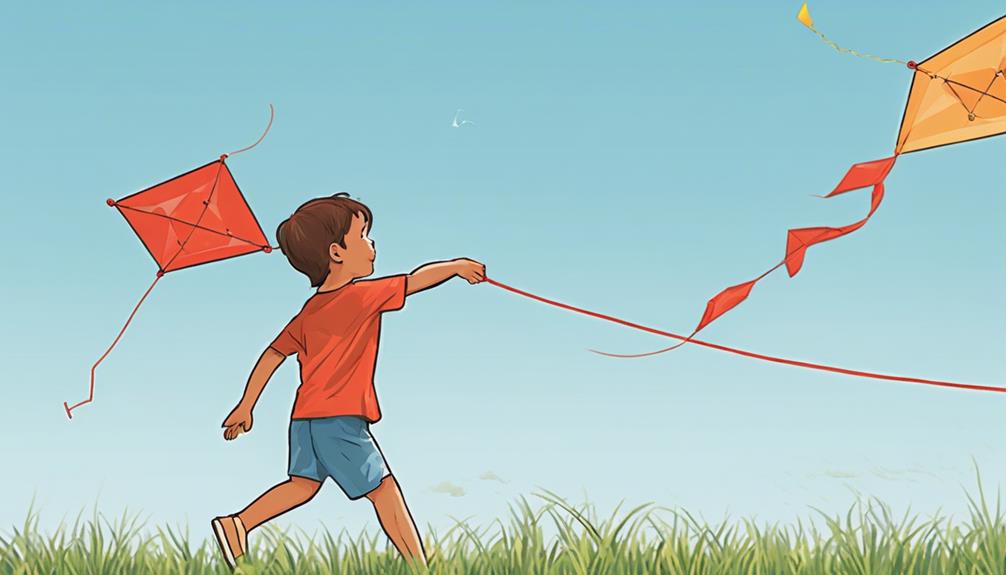Kite flying blends simplicity with the thrill of seeing your efforts soar high, yet many overlook the nuances that can turn this activity from frustrating to fulfilling for kids.
You’ve likely chosen your kite, be it a robust delta for those breezy afternoons or a forgiving diamond for the lighter winds, but the true art lies in mastering the launch and ensuring a smooth sail across the sky.
As you prepare to guide them, remember that the right technique can make all the difference. Stay with me as we unravel the secrets to a successful flight that will leave both you and the little ones eager for more.
Contents
Choosing Your Kite

Selecting the right kite, whether it’s a diamond, delta, or dragon for light breezes, or a box or parafoil for stronger winds, is a key step in ensuring your kite flying adventure is both successful and fun.
When you choose a kite, you’re not just picking a shape; you’re deciding on the kind of flying experience you and your kids will have. Different types of kites thrive in various wind conditions.
A diamond or delta kite dances gracefully in gentle breezes, making them perfect for beginners. In contrast, a box or parafoil kite is designed to soar high and steady in strong winds, offering a thrilling experience.
Ideal Flying Conditions

Often, finding the right wind conditions is crucial for a fun kite flying day with your kids. The ideal wind speed ranges between 5 to 25 mph, with medium speeds being perfect for little ones. Before heading out, it’s smart to check wind conditions using a weather app to ensure the day is just right for your adventure.
Here are some tips to keep in mind for the best experience:
- Look for steady winds; gusty conditions can make flying tricky.
- Choose open spaces like parks or beaches to avoid obstacles.
- Avoid flying near trees and crowded areas to keep your kite soaring high.
- Stay clear of power lines to ensure everyone’s safety and maximize enjoyment.
Preparing for Launch

Before you launch your kite, it’s crucial to choose the right type based on wind conditions. For lighter breezes, consider a diamond or delta kite, while a box or parafoil kite is better for stronger winds.
Planning to fly kites isn’t just about running into the wind; it’s about knowing the sky. Check the weather and pick open spaces like parks or beaches, where the air flows freely. Use a windsock test to find suitable wind conditions.
It’s fun to designate roles when flying a kite. One person can be the launcher, standing with their back to the wind, while the other becomes the flier, holding the string tight. Always wait for a gust of wind before you give it a go.
With the right preparations, you’re set for an uplifting adventure!
Mastering the Launch

Mastering the launch of your kite is easier than you might think, and it’s the first step to enjoying the sky dance. To ensure a successful takeoff, remember these key steps:
- Make sure the launcher faces away from the wind to catch the breeze just right.
- Find a spot free from obstacles and people to keep everyone safe.
- Wait for that perfect gust of wind to lift your kite up effortlessly.
- Keep a steady tension on the string, letting you and your launcher work in sync for control.
Getting your kite to soar involves coordination and a bit of patience. With practice, you’ll find launching becomes second nature, setting the stage for a stable and exciting flight every time.
Controlling the Kite

Now that your kite’s up in the sky, it’s time to learn how to keep it soaring beautifully.
You’ll get the hang of guiding your kite by feeling which way the wind’s blowing and tweaking the tails to make it dance in the air.
With a bit of practice, you’ll be steering it like a pro, making it swoop and glide wherever you want.
Mastering Wind Direction
To control your kite’s flight path effectively, it’s crucial to understand how wind direction impacts its movement in the sky. Mastering wind direction isn’t just about letting your kite fly; it’s about making deliberate adjustments to ensure stability and accuracy in its flight.
Here’s how you can get better:
- Observe how wind direction changes your kite’s behavior to learn how to adjust your control.
- Practice with different wind directions to improve your flying skills.
- Adjust the flying angle according to the wind to enhance stability.
- Focus on mastering these skills by regularly practicing, which will increase your control and accuracy.
Understanding and adjusting to wind direction are key steps in becoming a proficient kite flyer. Keep practicing, and you’ll see your kite soar!
Adjusting Kite Tails
Adjusting your kite’s tail can make a big difference in how it flies, giving you better control over its movements in the sky. By tweaking kite tails, you’re fine-tuning its stability and flight path. Longer tails help in light winds, adding stability, while shorter ones boost agility when the wind picks up.
Experiment with tail adjustments to see how they affect performance. This hands-on approach makes kite flying more enjoyable and responsive to changes in wind conditions. Here’s a quick guide to get you started:
| Tail Length | Wind Conditions | Effect on Kite |
|---|---|---|
| Longer | Light Winds | Increases Stability |
| Shorter | Strong Winds | Boosts Agility |
| Adjustable | Variable Winds | Enhances Responsiveness |
| No Tail | Experiment | Tests Limits |
Kids will love seeing how these changes impact their kite’s flight, making every outing an adventure.
Safe Landing Tips

Mastering the art of safely landing your kite ensures it’s ready for another day of soaring adventures. By learning how to gently bring your kite back to earth, you’re setting up for endless fun.
Here are a few tips to make sure your kite lands as smoothly as it flies:
- Gradually release the tension on the flying line to let your kite descend smoothly.
- Slowly reel in the line, guiding the kite towards the ground to avoid abrupt landings.
- Use gentle tugs on the line to control the descent and prevent sudden drops.
- Always practice landing in an open area, steering clear of obstacles that could damage or tangle your kite.
With these steps, you’ll be a pro at guiding your kite back to safety in no time!
Conclusion
You’ve picked the perfect kite, found the best day, and learned how to launch and control your kite like a pro.
Remember, flying a kite is all about having fun and learning together. Every tug and swirl teaches you a bit more about the wind and how your kite dances with it.
When it’s time to land, do it gently, like you’re tucking your kite into bed. Keep practicing, and each flight will be more amazing.
Happy flying!






